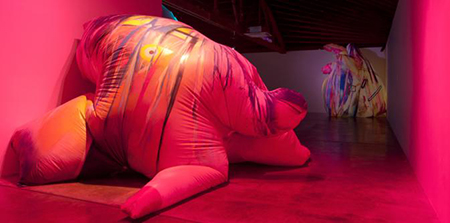
Continuing through November 2, 2014
When curator Rachel Adams arrived in Portland from Austin, Texas this summer and was introduced to the regional press, she trooped out one of contemporary art’s most overworked tropes. Her programming, she wanly proclaimed, would center around “the relationship of visual art to architecture.” Her goal for these behemoth main and side galleries, she continued, was “to engage the space in a way that’s site-specific.” You could practically see the eyes rolling, and glazing over, around town. When she later wrote, in press materials, that her debut exhibition, Claire Ashley and Bahar Yurukoglu’s "Intimate Horizons," would be “an exploration of form” that would “drive at deeper derivatives,” the response deepened to groans. Yet, for all the facile, preliminary pabulum-mongering, Adams has delivered her proof in the proverbial pudding: "Intimate Horizons" is one of the — if not the — most visually dynamic, architecturally responsive exhibitions I have encountered. Adams said she was going to engage the space, and by God, has she ever. With the possible exception of “Immaterialized” (2008), which featured a life-sized military tank suspended upside-down from the rafters, this vaulting cathedral of a gallery has never looked so intimate: filled with huge inflatables, video projections, and colorful abstract shapes that are perfectly scaled and positioned to maximize impact.
Ashley, who is based in Chicago, and the Boston-based Yurukoglu have joined forces for this installation and seamlessly merged their two very different aesthetics. Ashley contributes oversized inflatables that look like gargantuan plush-toys. Fashioned from PVC-coated canvas and spray-painted in exuberant hues, they’re sewn into vaguely animalian forms, plumped up with air by discreet fans dutifully whirring away. The works entitled "beauwoahzeau one and two" are ten-foot-tall blobs that look like a cross between a manatee and a toucan, their contours suggesting eyes, beaks, plumes, arms, and flippers. With their awkward features and fanciful colors, they endear themselves to the viewer with the charm of gentle giants. Like monumentally scaled pets or circus animals, they are mute, vulnerable, and strangely tragic.
Yurukoglu counters Ashley’s insouciant forms with rigorous rectilinear planes, which she calls “neoscapes.” In “Omun” Yurukoglu installs clear Plexiglas squares, rectangles, and triangles of varying dimensions across the northwestern exposure, from which they jut out at ninety-degree angles, like a rock-climbing wall designed by Gerrit Rietveld. While the shapes’ colors are ebullient and their placement jauntily rhythmic, they exude the diametrically sinister aura of jagged glass, with unsettling overtones of Kristallnacht. One even imagines the nearby inflatables, with their elephantine or whale-like proportions (and both of those species with long histories of persecution at human hands), as having been herded into a slaughterhouse or death chamber. Suddenly the vast exhibition space turns chokingly claustrophobic. To shrink this enormous hall so radically by implication is an impressive, if perverse, spatial and psychological feat in and of itself.
Finally, the two artists’ sensibilities come together in unlikely harmony in the collaborative piece, "B-15." It’s Ashley’s inflatable appointed with Yurukoglu’s Plexi panes. So congruous are this piece’s sculptural and video elements that a casual viewer could be forgiven for assuming it was the work of a single artist. Throughout the exhibition, the artists toy with our emotional and kinetic responses in disarmingly affecting ways. With this simultanously hilarious and horrifying show, Adams proves she is a curator not to be underestimated.
